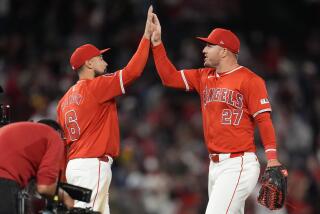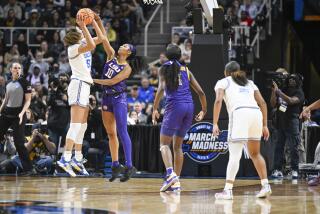It’s on Their Shoulders
- Share via
There were no doubts in the mind of Arizona Manager Buck Showalter. After watching Darin Erstad shred the Diamondbacks for 10 hits in 14 at-bats in a three-game series in June 1998, he predicted the young Angel outfielder would soon blossom into a perennial candidate for most valuable player.
“He’s one of my favorite players in the American League,” Showalter said at the time. “I love watching him play.”
After batting .313 with 18 home runs and scoring 59 runs in the first half of the season, Erstad made the All-Star team in 1998. It was exactly the kind of high-octane performance the Angels had expected from Erstad, whose combination of speed, power, skill and intensity made him the No. 1 pick in the 1995 draft.
So, who is this impostor who has been wearing Erstad’s uniform for the last year and a half?
Since that 1998 All-Star break, Erstad has hit .255 with 14 home runs and 76 runs batted in in 754 at-bats, roughly the equivalent of 1 1/2 seasons, staggering figures considering his torrid first half of ’98. He struck out a career-high 101 times and had a .308 on-base percentage in 1999, hardly the kind of production expected from a leadoff hitter.
Many players have bad months, bad halves, bad years, but a year and a half of struggling has raised serious questions about Erstad.
Once considered untouchable, his name surfaced over the winter in trade rumors. Persistent shoulder and hamstring problems have zapped him of some arm strength and speed. Some wonder whether the rising star once considered a potential franchise player will break out soon or continue to muddle along.
“That’s why this is such a big year for him,” said a scout who follows the Angels regularly. “If he hits .250 again with 12 homers and 50 RBIs, is that the type of player he is? Is that the type of player he’s going to be?”
Erstad knows the statistics. He knows what the scouts are thinking and saying. He knows what front-office executives are wondering.
He doesn’t care.
“The one thing I’ve come to learn, and it hit me toward the end of last year, is, I don’t have to prove anything to anyone,” Erstad, 25, said. “You hear good things and bad things said about you, and if you want to say this is a make-or-break year, go ahead. I’m not going to put that pressure on myself.
“No can predict the future, but I know in my heart that if I’ve given my all, I can’t get too mad at the results. I think I lost that last year. I had always had fun playing the game, but I didn’t last year. I let some things affect me. . . .
“But I have to look at it like the stock market. If you’re a day trader, you can’t let the ups and downs affect you. You have to look at a 20-year career and say 1999 was a blip.”
Or was the first half of 1998 the blip? If Erstad doesn’t correct the flaws in his swing that confounded him in 1999, if he can’t lay off the pitches that have given him the most trouble, scouts and front-office types could come to that conclusion.
And if Erstad can’t better ignite an offense that lost some punch by trading Jim Edmonds, the Angels will have trouble keeping pace in the American League West.
Erstad, though, has a good feeling about 2000.
“This is the best I’ve felt since 1997,” he said of a spring in which he hit .370--he had a 15-game hitting streak--with two homers and 11 RBIs and is running as well as ever.
“I can’t explain why, but from Day 1 of spring training last year, I wasn’t comfortable in the batter’s box. There wasn’t one day all season I felt comfortable.
“Now, I’m comfortable, and it’s a great feeling. That’s all I need. . . . It was a good winter to clean the head out. Maybe I needed to hit rock bottom to get better.”
There are several theories as to why Erstad bottomed out. With so much pressure on teams to bring No. 1 picks to the big leagues right away, Erstad had only 482 minor league at-bats, not nearly enough, scouts say, to prepare him for big league pitching.
Angel outfielders Garret Anderson, with 2,042 at-bats, and Tim Salmon, with 1,285, served considerably longer apprenticeships in the minor leagues.
Erstad was a four-sport star--baseball, football, hockey, track--at Jamestown High in North Dakota, he starred for the Nebraska baseball team and punted for the Cornhusker football team, and he didn’t really experience failure in sports until he reached the big leagues, where the spotlight is the brightest, the pressure most intense.
“I don’t think you learn to hit at the big league level,” one National League scout said. “It goes back to the mental aspects of the game, the ability to make adjustments, and that’s tough to do for the first time in the big leagues. All players go through periods of self-doubt, and if your confidence wavers, it can affect your performance.”
Scouts began to notice choppiness in Erstad’s swing in the second half of 1998. The bat head wasn’t reaching the hitting zone as quickly as it once had. The pitches Erstad had hit to the opposite field wound up more and more as weak grounders to the left side.
“I got it handed to me, totally, last year,” Erstad said. “I wasn’t smart enough to figure out what pitchers were doing, and I didn’t make the adjustments. You can’t let people get you out the same way all the time.
“I internalized a lot, and instead of seeing certain situations, thinking about what a pitcher is doing to get you out, I was thinking about mechanics. Then, boom, before I knew it, I was out.”
Erstad, a line-drive hitter who doesn’t have the natural uppercut of many left-handed swingers, has always been a “feel” hitter, meaning he has never been as concerned with the mechanics of his swing as he is with the comfort of it and his recognition of the pitch.
But former Angel batting instructor Rod Carew noticed a serious flaw last season. When Erstad was ready to swing, when his body was shifting forward and his front foot hitting the ground, his hands were moving backward instead of forward. That threw off his timing and slowed his bat.
“It’s tough to figure that out in the middle of the season, and I got into some bad habits,” Erstad said. “But if you slap yourself in the head enough times and run into a few walls with your head, you realize how stupid you’ve been. I finally saw the light. I know I’ve corrected my swing [this year]. I can just feel it.”
But a mechanically sound swing may not help Erstad battle his Achilles’ heel--the hard breaking ball that right-handers start outside and bust low inside, at Erstad’s knees and shins.
Opponents discovered this weakness in the second half of 1998, and it was usually the pitch Erstad struck out on, or hit for a weak grounder.
“I have to learn to not swing at that pitch . . . or only swing at it if I absolutely have to,” Erstad said. “Some guys learn to foul off tough pitches with two strikes, and that’s something I have to do. It’s a mind-set. You have to go into it saying, ‘I can’t drive that ball,’ so just try to put it in play hard on the ground.”
Erstad appeared to have made some progress this spring. In one Cactus League game, in consecutive at-bats, he hit low inside breaking balls from right-handers for ground-ball singles, one up the middle and one through the second-base hole. Both of his homers--on high-velocity fastballs--resembled many of his 1998 shots, wicked line drives that carried over the fence.
But he knows until he shows he can handle this pitch more consistently--or lay off it--opponents will attack him with it.
“You see a weakness, you go for the jugular--I don’t blame them,” Erstad said. “I took my beating like a man, but what goes around comes around. That’s a good thing to remember.”
That last statement was accompanied by a glare that could pierce Kevlar. The famous Erstad intensity was coming to the surface. When told he seems like a man on a mission in 2000, Erstad snapped:
“I’ve been on a mission since the day I put diapers on.”
Erstad isn’t sure why, but even as a child, he was much more competitive than other kids.
“I cried when we lost, and I wouldn’t talk to my folks for days sometimes,” Erstad said. “For other kids, it was like nothing happened. Even playing Wiffle ball in the backyard, I’d toss the bat and try to break something if I lost. Some kids played to have fun, and that’s great, but for me, fun was winning.”
Erstad said he’s getting better at leaving that anger and frustration at the park, and his wife, Sarah--she and Erstad, who knew each other in high school, were married in January--acknowledges he has made strides.
“But I remember some nights after games in high school, I couldn’t talk to him,” Sarah said. “One time they lost an American Legion state championship game in Mandan, North Dakota. I drove 100 miles to get to the game, and he didn’t talk to me afterward.”
Erstad still has such moments. Last summer, he became the first Angel to publicly rip his teammates in the midst of an 11-game losing streak that knocked the Angels out of the AL West race after the All-Star break.
Erstad criticized the underachieving Angels for having “a divided clubhouse. . . . There’s not a feeling that everyone is in the same corner.” He said the Angels were soft, and that winning wasn’t their No. 1 priority.
He made those comments before a game in Texas on July 21, during an interview in which he seemed to be in a controlled rage. He never raised his voice. He just sat with a scowl on his face, methodically shredding the Angels, exposing them for what they were.
Erstad’s comments ignited a simmering powder keg, and players spent much of the next month bickering, to the point that Angel President Tony Tavares likened the clubhouse to a “day-care center.” The turmoil eventually cost Manager Terry Collins and General Manager Bill Bavasi their jobs, and Erstad felt great remorse in the wake of their dismissals.
But that won’t prevent him from speaking out in the future.
“I said what I had to say, and that’s over and done, but if something needs to be said, I’ll say it again,” Erstad said. “I have no regrets.”
This no-nonsense approach plays well with coaches, scouts and front-office executives. They love the mental makeup of a player who races toward the wall in foul territory and attempts a dangerous sliding catch of a pop fly with his team trailing by six runs in the eighth inning, as Erstad did in Denver’s Coors Field last July.
They love the way Erstad throws his body around the field with no apparent fear of injury and the way he takes out infielders trying to break up double plays. They love that when the Angels asked him to move to first base in 1997, even though he had never played the position, he put the team ahead of himself, immersed himself in the new position and became a top-notch defender.
They love that while so many players seem content after signing fat contracts and are more concerned with individual success than team goals, Erstad has his priorities in order.
“I could hit .250 and win the World Series and be the happiest guy in the world,” Erstad said.
Intensity does have its drawbacks, though. At one point last summer, Erstad was pressing so hard at the plate that former third base coach Larry Bowa said it looked as if Erstad could squeeze sawdust out of his bat. Erstad gets so frustrated sometimes, it affects his concentration.
“Sometimes I’m not playing baseball out there, I’m playing a contact sport,” Erstad said. “Everyone has a fiery competitiveness, but some use it in a more productive manner. I’m still honing that skill, learning that the game is more of a chess match instead of a contact sport.”
Of course, Erstad was no different in the first half of 1998.
“It’s a double-edged sword,” he said. “No one complained about my intensity when things were going good. I was pretty tightly wound when I was having success in 1998.”
(BEGIN TEXT OF INFOBOX / INFOGRAPHIC)
Season Highs
This is Darin Erstad’s fourth season with the Angels:
Hits: 161 (1997)
HRs: 19 (1998)
RBI: 82 (1998)
Avg.: .299 (1998)
Runs: 99 (1997)
Darin Erstad
1999
Avg.: .253
HR: 13
RBIs: 53
Slug.%: .374
Runs: 84
SB: 13
*
Career
Avg.: .282
HR: 52
RBIs: 232
Slug.%: .433
Runs: 301
SB: 59
More to Read
Go beyond the scoreboard
Get the latest on L.A.'s teams in the daily Sports Report newsletter.
You may occasionally receive promotional content from the Los Angeles Times.







